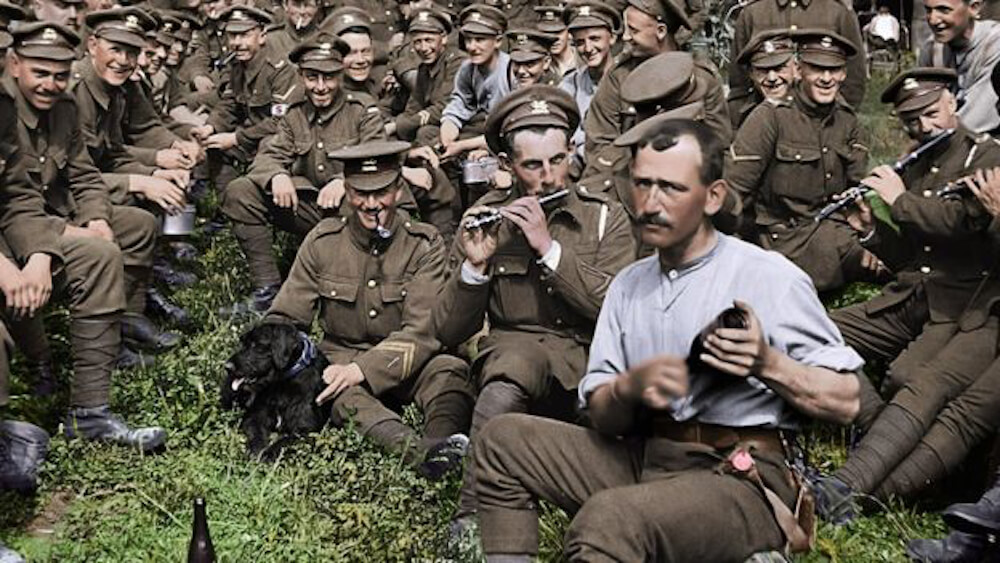Special Guest Post: A Look At Peter Jackson’s First World War Epic

In a special guest post for FRONTRUNNER, Fraser McCallum takes a look inside Peter Jackson’s documentary They Shall Not Grow Old, produced in conjunction with the BBC, 14-18 NOW and the Imperial War Museum, London. Using groundbreaking techniques and in-depth research, Jackson’s film pushes into new territory what is possible in the art of reviving and reinstating the potency of historical and archival film.

Dir. Peter Jackson
Colorized footage (artistic rendition)/Original black and white film
WingNut Films with Peter Jackson
Image courtesy of IWM/WingNut Films
Peter Jackson, best known for his Academy Award-winning The Lord of the Rings trilogy and his subsequent series of films based on J.R.R. Tolkien’s The Hobbit, has produced an extraordinary new documentary marking the centenary of the end of the First World War.
For They Shall Not Grow Old, Jackson employs state-of-the-art techniques to restore and re-colorize 100 year-old film from the depths of the Imperial War Museum’s archive, and blend it with vivid, often shocking, and sometimes funny oral testimony from veterans of the conflict; recordings that IWM and the BBC have collected since the 1960s. Technically, the results are astounding. The frame rate has been increased from an average of 16 FPS to 24 FPS. As a result, the jerking movements – a feature of so many silent films – are no more. Such is the transformative nature of the restoration of the clips used in the film, one could easily mistake them for recently-shot footage from a forthcoming war epic.

About 25 minutes in, Jackson expands the screen ratio from Academy 4:3 to an enveloping widescreen format and transitions from monochrome into beautifully rendered, digitised color. The impact of this transition is difficult to describe: watching it results in a deep inhale on each viewing as young men, hitherto distant, come vividly into life. This is no botched job either and is as far removed from those Ted Turner-sponsored, 1980s attempts at colorising It’s a Wonderful Life, as can be imagined.
The palette is subtle and lifelike. The hues of uniforms, shells, tanks, are all accurate and authentic. It is in these details that the filmmakers’ connection with the museum and its repository of archival collections bares fruit. Even more staggering is the synchronised sound added to the formerly silent utterances of these moving images. Here, Jackson and his team have employed expert lip readers, and then have recruited actors to give voices to them, using dialects chosen to match the regional regiments to which the soldiers belonged to.
It is a bold move, and one that must have required painstaking work, but one that has enormous emotional impact.

Dir. Peter Jackson
Colorized film footage
Photo credit: BBC
Image courtesy of IWM/WingNut Films
Narratively, the film attempts to give a sense of what it was like to experience the First World War on the lines of the Western Front. It is a particularly British story in this telling as Jackson was limited in his scope of available footage. Some may bristle at the absence of soldiers of color – some 20 per cent of the 8.5 million men who fought for Britain in the First World War were drawn from India, Africa, and the Caribbean – but They Shall Not Grow Old does not attempt to tell the whole story of the war. Rather, it illuminates a part of it that we thought we knew. For some, the fact this work comes from the director of a fantasy masterpiece may be somewhat surprising, even disconcerting. It should be noted, however, that Tolkien’s magnum opus was formed in the trenches of France and Belgium, thus not unusual for it to be read by scholars as a treatise on The Great War. In this respect, Jackson (who owns a large collection of First World War memorabilia and operates a subject-related museum in his native New Zealand) is the perfect artist for the project, adding a further layer of intertextuality to the work. The Battle of Helm’s Deep may never been seen again in the same way after watching the slaughter on the Western Front.
For American audiences, the techniques involved and the scale of human loss depicted will make for powerful viewing, For a UK audience – which has responded so viscerally to the film that extra showings have been added to the release schedule not once, but three times – the experience is altogether more affecting.
In the collective British memory, The First World War is akin to the Civil War. The Somme is our Gettysburg: a watershed moment in history that defines who we were, and what we were to become. At the end of a four-year cycle of commemoration and remembrance marking the centenary of this conflict, Peter Jackson has made a work of art that will profoundly impact the way we remember this “War to end all Wars” in its second centenary.










